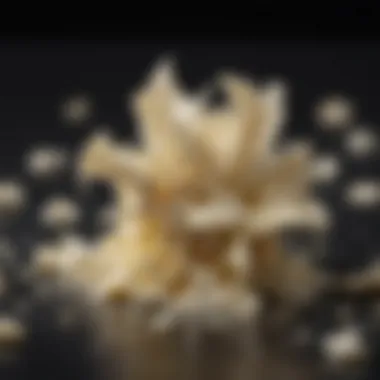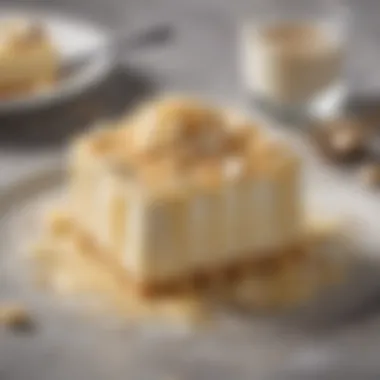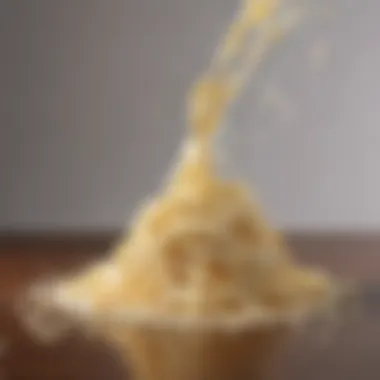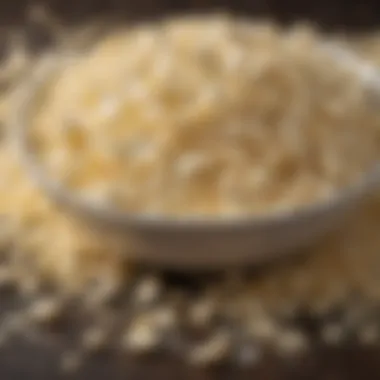Exploring the World of White Chocolate Shavings


Intro
White chocolate shavings are a delightful addition to various desserts and culinary creations. Unlike traditional chocolate, white chocolate has its unique flavor profile and texture. Though it may be less common in some circles, its versatility makes it a valuable ingredient for both sweet and savory dishes.
In this article, we will examine white chocolate shavings in depth. We’ll uncover their history, explore preparation techniques, and showcase diverse applications. As we navigate through this exploration, readers will gain insights into how to effectively incorporate white chocolate shavings into their cooking.
Understanding the intricate balance between flavors will also be addressed, enriching one’s culinary arsenal. Ultimately, the aim is to inspire creativity and make white chocolate shavings a staple in any kitchen.
Preamble to White Chocolate Shavings
White chocolate shavings are not just a decorative element but a delightful addition to various culinary creations. They play a crucial role in elevating the taste and aesthetic appeal of desserts and other dishes. Understanding white chocolate shavings involves grasping their definition, characteristics, and historical context. This knowledge can lead to better utilization of these shavings in cooking and baking.
Definition and Characteristics
White chocolate, despite its name, is not technically chocolate in the traditional sense as it doesn’t contain cocoa solids. Instead, it is made from cocoa butter, sugar, and milk solids. These core ingredients impart a creamy, sweet flavor, distinguishing white chocolate from its darker counterparts.
White chocolate shavings are created by processing solid white chocolate through techniques that yield thin curls or flakes. The texture can vary, ranging from delicate wisps to thicker shavings, depending on how they are made. When used as a topping or ingredient, these shavings not only add sweetness but also a subtle richness that can enhance the overall dish.
Historical Background of White Chocolate
The origins of white chocolate can be traced back to the 1930s when it was first developed as a way to utilize excess cocoa butter produced during the manufacturing of cocoa products. Nestlé's introduction of a white chocolate bar in the early 1940s significantly popularized this product. Over the years, white chocolate has evolved not just in form but in culinary applications as well. Today, it is celebrated in various dishes, particularly in confections and desserts where its sweet, creamy profile adds depth and balance.
Understanding the ground upon which white chocolate shavings are built helps in appreciating their broad applications in culinary practices. Their gentle sweetness serves as a perfect complement to bitter, tart, or spicy flavors, making them a versatile tool in any chef's arsenal.
The Composition of White Chocolate
Understanding the composition of white chocolate is crucial for grasping its unique qualities and culinary applications. Unlike its counterparts, white chocolate lacks cocoa solids, which sets it apart both in flavor and texture. This article will break down the essential ingredients and highlight the differences between white chocolate and other types, providing food lovers with a clear perspective on this delightful confection.
Ingredients of White Chocolate
White chocolate is primarily made from three key ingredients: cocoa butter, sugar, and milk solids. Cocoa butter, the fat derived from cocoa beans, is essential as it gives white chocolate its smooth texture and rich mouthfeel. The absence of cocoa solids means that white chocolate does not possess the typical chocolate flavor, but it offers a sweet and creamy taste experience.
Sugar is the primary sweetener in white chocolate, balancing the richness of cocoa butter and adding to the overall sweetness. The quality of sugar can greatly influence the final product's flavor and texture. Milk solids, which include milk powder, contribute to the creamy character and provide added richness. The proportions of these ingredients can vary, impacting the taste and quality of the final product.
Additional ingredients often include emulsifiers and stabilizers, such as lecithin, which help bind the ingredients together and enhance the texture. Some artisanal varieties might incorporate flavoring agents like vanilla to deepen the sweet profile. Overall, the composition of white chocolate is designed to provide a pleasant sweetness while focusing on the creamy notes of cocoa butter.
Differences Between White Chocolate and Other Types
While white chocolate shares some similarities with dark and milk chocolate, it is exceptionally distinct due to its lack of cocoa solids. This absence means that white chocolate does not deliver the characteristic bitterness associated with dark chocolate or the balanced flavor profile found in milk chocolate.
- Flavor Profile: Dark chocolate presents a rich, intense flavor, whereas white chocolate is sweeter and creamier without the cocoa bitterness.
- Sugar Content: White chocolate typically has a higher sugar content compared to dark and milk chocolate. This can make it more appealing for those who prefer sweeter confections.
- Culinary Uses: White chocolate's unique flavor makes it suitable for a variety of applications, from desserts to savory dishes. In contrast, dark chocolate is often used for its depth of flavor in sauces and desserts, and milk chocolate is frequently utilized in confections and candies.
In summary, the composition of white chocolate, with its key ingredients of cocoa butter, sugar, and milk solids, sets it apart from its chocolate counterparts. This distinction enhances its versatility in culinary uses, providing numerous opportunities for creative expression in the kitchen.
Techniques for Creating White Chocolate Shavings
Creating white chocolate shavings is a fundamental aspect of culinary arts, especially for those who enjoy using chocolate as a decorative and flavorful component in desserts. Understanding the various techniques for making these shavings can significantly elevate the presentation and taste of your dishes. White chocolate shavings not only add texture and visual appeal but also introduce a subtle sweetness that complements other flavors in a dish. The process of creating these shavings requires attention to detail, careful selection of tools, and a systematic approach to achievable outcomes, making it incredibly valuable for both amateur and professional cooks.
Essential Tools and Equipment


To create white chocolate shavings, having the right tools and equipment is essential. Here is a list of key items you will need:
- High-Quality White Chocolate: Start with a premium brand to ensure better flavor and texture. Some popular choices include Ghirardelli and Callebaut.
- Grater or Microplane: These tools are ideal for producing fine shavings. A box grater can also work, but using a microplane gives a finer result.
- Sharp Knife: For larger shavings, a chef's knife is effective. The blade should be smooth to prevent rough edges.
- Peeler: A vegetable peeler can create elegant curls and ribbons of white chocolate.
- Sheet Pan or Parchment Paper: Use these to catch the shavings and facilitate easy transfer to your desserts.
Having these tools at your disposal will ensure that the process runs smoothly and results are visually appealing.
Step-By-Step Process for Making Shavings
Creating white chocolate shavings can be broken down into a few straightforward steps. The following guide outlines an easy method to achieve beautiful shavings:
- Select Your Chocolate: Choose a high-quality white chocolate bar. Make sure it is kept at room temperature for best results.
- Prep Your Tools: Gather your grater, knife, or peeler. Make sure everything is clean and dry.
- Shave the Chocolate:
- Collect the Shavings: Allow the shavings to fall directly onto the sheet pan or parchment paper for easy access.
- Use or Store: The shavings can be used immediately or stored in an airtight container in the fridge for future use.
- If using a grater or microplane, hold it over the sheet pan. Rub the chocolate against the grater at a slight angle to create fine shavings.
- For a knife, gently slide the blade over the chocolate bar while applying slight pressure. This will yield larger pieces.
- With a peeler, press down on the chocolate bar, moving in a smooth motion to create beautiful curls.
Important: Ensure that the chocolate is not warm to avoid melting.
By following these steps precisely, you will create shavings that are perfect for enhancing various culinary creations. Experiment with different techniques and tools to find what works best for you.
Incorporating White Chocolate Shavings Into Recipes
The incorporation of white chocolate shavings into recipes presents a realm of culinary exploration. These delicate flakes of sweetness can enhance a variety of dishes across both sweet and savory spectrums. By understanding the practical applications and the unique flavors they bring, one can elevate their culinary creations significantly.
Notably, white chocolate shavings contribute both aesthetic appeal and texture to dishes. Their light and airy composition allows them to add a layer of sophistication without overwhelming other flavors. Furthermore, the creamy, sweet profile of white chocolate provides a contrast that can balance acidity or bitterness in some recipes. It is essential to realize that how one chooses to incorporate these shavings can affect the overall harmony of the dish.
Usage in Baking and Pastry
Baking is perhaps the most familiar domain for white chocolate shavings. They can be folded into batters or sprinkle on top of baked goods. Including white chocolate shavings in cookies or cakes creates delightful pockets of sweetness as they melt slightly during baking. For instance, a classic chocolate chip cookie can be elevated with an addition of white chocolate shavings, creating a diverse flavor profile that suggests new dimensions.
Consider using shavings in a rich cheesecake. When mixed into the cream cheese base or served as a topping, they add both taste and texture. Further, when making meringue-based desserts or pavlovas, incorporating white chocolate shavings can provide visual interest and a sweet crunch.
Savory Applications: Breaking Culinary Boundaries
Contrary to the conventional wisdom that white chocolate should remain in sweet dishes, creative cooks have started experimenting with savory uses. Pairing white chocolate shavings with cheese or charcuterie brings an unexpected sweet contrast that can surprise and delight.
For example, shavings can be paired with a salt-aged cheese. The creaminess from the white chocolate can soften the palate when combined with the robust flavor of the cheese. Furthermore, incorporating white chocolate into a salad dressing can balance tangy vinaigrettes. This fusion of flavors illustrates the adaptability of white chocolate in diverse culinary contexts.
Innovative Pairings with Other Ingredients
The key to creating an appealing dish lies in choosing complementary flavors. White chocolate shavings work well with various ingredients, allowing chefs to push culinary boundaries. On the savory side, pairing them with herbs like basil or mint could lend a refreshing element. The herbal notes can create a surprising but pleasing taste experience.
On the sweeter side, combining white chocolate shavings with fruits like raspberries, strawberries, or citrus can yield delightful combinations. These fruits offer acidity that cuts through the sweetness, ensuring that no single flavor dominates.
Important Note: Experimentation is crucial. This flexibility encourages creativity in the kitchen and opens up a variety of possibilities for innovative culinary expressions.
In summary, incorporating white chocolate shavings expands the potential of culinary creations. By understanding different applications, one can adequately leverage their unique properties. Transitioning these shavings across sweet and savory dishes not only enhances flavor but also invites a deeper appreciation for the versatility of white chocolate.
Links for further reading: Wikipedia, Britannica, Reddit, Facebook
Thus, white chocolate shavings are invaluable in both aesthetic and flavor-forward cooking.


Aesthetic Uses of White Chocolate Shavings
The aesthetic uses of white chocolate shavings serve as a fundamental aspect in both the culinary world and dessert presentations. Their visual component can transform ordinary dishes into exceptional culinary experiences. Notably, adding white chocolate shavings not only enhances the look of the dish but also complements the overall flavor palette. The delicate, creamy color of these shavings contrasts pleasingly with various dessert bases, making them visually appealing while inviting diners to indulge. Incorporating aesthetic elements is crucial in food presentation since how a dish looks can significantly influence the perception of its taste.
Presentation Techniques for Desserts
When working with desserts, employing white chocolate shavings is a technique that can elevate the presentation. The shavings can be scattered elegantly over a dessert plate or heaped on top of a cake or pie. This not only adds a touch of sophistication but also provides texture contrast that engages the senses. White chocolate shavings can be fashioned into decorative curls or rosettes, contributing an artistic flair that pleases the eye. For example, a simple arrangement of shavings can transform a plain cheesecake into a gourmet masterpiece.
- Layering: Create dimension by layering shavings between cake layers or within a parfait. This technique adds complexity to both flavor and appearance.
- Sprinkling: Generously sprinkle shavings over mousses, puddings, or ice cream for a surprise element as people dig in.
In many gourmet settings, the art of plating is taken seriously. Chefs often invest time in ensuring that white chocolate shavings are arranged purposefully, drawing attention to the dessert rather than overwhelming it.
Creating Visual Appeal in Culinary Art
The aesthetic role of white chocolate shavings extends beyond sweet dishes. Chefs and home cooks alike can use these shavings to create visual appeal in savory items as well. When strategically placed, shavings can lend a luxurious finish to creamy soups or garnished entrees, thus blurring the lines of conventional dessert boundaries.
- Color Contrast: The creaminess of white chocolate shavings juxtaposed against colorful fruits or vibrant sauces enhances the visual impact.
- Natural Decorations: Pairing white chocolate with natural elements, like fresh berries or edible flowers, results in an elegant presentation that captivates any audience.
"Food presentation is an art form, where white chocolate shavings can play a key role in enhancing the aesthetic appeal of culinary creations."
Nutritional Aspects of White Chocolate
Understanding the nutritional aspects of white chocolate is key to appreciating its role in both culinary and health contexts. As food enthusiasts, it is important to analyze not only the flavor profiles and aesthetics of white chocolate shavings but also their nutritional contributions and potential drawbacks. This section will delve into the ingredients and nutritional content of white chocolate, along with how it compares to darker varieties.
Understanding Nutritional Content
White chocolate, unlike its darker counterparts, is primarily made from cocoa butter, sugar, and milk solids. These ingredients contribute to both its creamy texture and its sweetness. The absence of cocoa solids in white chocolate means it lacks the flavonoids found in dark chocolate, known for their antioxidant properties. Nevertheless, white chocolate does boast a significant caloric content, primarily from the sugars and fats present.
Nutritional Breakdown:
- Calories: A typical serving of white chocolate can contain approximately 150 to 200 calories.
- Fat: Around 10 to 12 grams, most of which are from cocoa butter.
- Sugar: Can encompass 10 to 15 grams.
- Protein: Typically low, around 2 grams per serving, mainly from milk solids.
While white chocolate can provide quick energy due to its sugar content, excessive consumption may lead to weight gain and other health issues. Moderation is essential. Additionally, white chocolate does not provide as many vitamins and minerals compared to dark chocolate.
Comparative Analysis with Dark Chocolate
When comparing white chocolate to dark chocolate, distinct differences in flavors, textures, and nutritional values become evident. Dark chocolate is often praised for its higher cocoa solid content, yielding a richer flavor and numerous health benefits. These benefits include improved heart health and cognitive functions due to the presence of flavonoids. In contrast, white chocolate does not offer the same advantages.
- Antioxidant Levels: Dark chocolate contains more antioxidants than white chocolate. This makes it beneficial for reducing oxidative stress.
- Sugar Content: White chocolate typically has higher sugar content. The extra sugars lead to a sweeter taste but can have negative impacts on health if consumed in excess.
- Tastes and Pairing: Dark chocolate often pairs well with various bold flavors, while white chocolate complements softer, creamier ingredients.
"The appeal of white chocolate lies in its ability to enhance culinary dishes without masking underlying flavors."
In summary, while white chocolate shavings can enrich desserts and create beautiful presentations, they should be enjoyed within the context of a balanced diet. Understanding their nutritional content and limitations allows consumers to make informed choices, promoting a healthier culinary experience.
Cultural Significance of White Chocolate Shavings
White chocolate shavings hold an intriguing position within various culinary traditions. While often overshadowed by dark and milk chocolates, they play a unique role in different cultures. Their light color and sweet flavor offer versatility that can enhance dishes both visually and gustatorily. This exploration of cultural significance unveils how white chocolate shavings inspire creativity in cuisines worldwide.
Regional Variations in Use


The use of white chocolate shavings varies across regions, reflecting local culinary preferences and traditions. In several European countries, such as France and Switzerland, white chocolate is increasingly featured in pastries and confiseries. French patisseries often utilize white chocolate shavings to elevate the presentation of delicate desserts. Meanwhile, Italian gelato makers may combine white chocolate shavings with citrus flavors, resulting in refreshing and enticing combinations.
In Asian cultures, especially in Japan, white chocolate has synced well with traditional sweets. Sakura-flavored white chocolate shavings can be found atop mochi, presenting a fusion that merges taste and aesthetic appeal. This signifies a broader trend where white chocolate incorporates itself into cultural practices, translating into a new culinary language.
Influence on Modern Culinary Trends
The presence of white chocolate shavings in contemporary cuisine reflects a shift towards diversity and experimentation. Chefs and home cooks alike explore its usage in unexpected ways. White chocolate’s creamy texture avoids overpowering other flavors and complements a range of ingredients, from fresh fruits to rich spices.
Today, desserts featuring white chocolate shavings appear on menus of upscale restaurants, often paired with elements like matcha, lavender, or chia seeds.
Moreover, social media platforms amplify this influence. The visual appeal of white chocolate shavings garnishing desserts leads to increased sharing and imitation among food enthusiasts. This phenomenon highlights their role not just as ingredients but as modern cultural icons.
"Inculcating white chocolate shavings into culinary creations can spark innovation that appeals to the aesthetic senses of diners."
Challenges and Considerations
Understanding the challenges that come with working with white chocolate shavings is crucial for achieving culinary success. There are specific elements to consider that can affect both the quality of the shavings and their application in various dishes. Identifying common issues and knowing how to resolve them can elevate the experience of creating and using white chocolate shavings.
Common Mishaps in Shaving Techniques
Creating perfect white chocolate shavings is not as straightforward as it might seem. Several common mishaps can occur during the shaving process.
- Temperature Sensitivity: White chocolate is sensitive to temperature. If it's too warm, the chocolate can melt, making it challenging to shave. Conversely, if it's too cold, the chocolate might become too brittle, resulting in smaller, uneven shavings.
- Tool Selection: Using the wrong tools can lead to poor results. A dull knife will not create clean shavings, while a vegetable peeler might take off too much at once.
- Surface Matters: The surface on which the shaving occurs can influence the outcome. A non-stick surface is ideal, as it prevents the chocolate from sticking and tearing during the process.
To avoid these issues, keep white chocolate at a moderate room temperature before attempting to shave. Use a sharp knife or a quality grater, and always work on a clean, slick surface. This attention to detail ensures that the shavings will turn out beautifully, adding the right touch to any dish.
Addressing Identification of Quality White Chocolate
Determining the quality of white chocolate is essential for perfecting shavings. Not all white chocolates are created equal, and various factors influence their quality.
- Ingredients: The first indicator is the ingredient list. High-quality white chocolate will primarily contain cocoa butter, sugar, and milk solids. Avoid products that list vegetable oils or artificial flavorings.
- Cocoa Butter Content: Look for a minimum of 20% cocoa butter. Higher cocoa butter content usually leads to a better mouthfeel and smoother texture, which is crucial when shaving.
- Taste and Texture: Quality white chocolate has a creamy texture and a rich, sweet flavor. It should not taste waxy or overly sweet. Conducting a taste test can help in selecting the best option.
It's worth noting that craftsmanship goes beyond ingredients. The chocolates from reputable brands like Callebaut and Valrhona offer consistent quality that can significantly enhance culinary creations.
When working with white chocolate shavings, always start with high-quality chocolate. This will not only improve the aesthetics of your dishes but also elevate their overall flavor profile. By paying attention to techniques and identifying quality products, you can fully appreciate the culinary potential of white chocolate shavings.
Culmination: The Value of White Chocolate Shavings
The exploration of white chocolate shavings concludes with an understanding of their multifaceted value in culinary arts. They not only enhance aesthetic appeal but also enrich flavors, making dishes more enjoyable and refined. This section encapsulates significant elements surrounding their use, including their historical significance, technical aspects of preparation, and culinary versatility.
White chocolate shavings hold a unique position in the kitchen. They serve as a versatile ingredient that can be incorporated in various recipes. From cakes to savory dishes, they introduce a creamy texture and delightful sweetness. The discussions throughout this article emphasize how white chocolate shavings can elevate ordinary dishes to extraordinary culinary experiences.
Moreover, their aesthetic qualities make them indispensable in modern presentation techniques. Chefs and home cooks alike can use white chocolate shavings to create visual stories on the plate. Their ability to complement both sweet and savory elements while adding a luxurious touch cannot be overstated.
Summary of Key Points
- Unique Attributes: White chocolate shavings provide visual and textural enhancements to dishes.
- Versatile Usage: They can be effectively used in both sweet treats and unexpected savory recipes.
- Artistic Presentation: These shavings contribute to the artistic side of culinary presentation, making dishes more appealing.
- Culinary Experimentation: The article outlines various techniques and recipes that leverage white chocolate shavings in innovative ways.
"Culinary creativity is about not being afraid to experiment with flavors and presentations. White chocolate shavings are a perfect medium for such exploration."
Encouragement to Experiment in Culinary Arts
As we concluded the exploration of white chocolate shavings, it is clear that they invite creativity and experimentation in the kitchen. Every food lover, regardless of experience level, should feel encouraged to incorporate these shavings into their cooking. There is significant value in trying new pairings and techniques. By experimenting, one can discover unique combinations that resonate with personal tastes.
Consider trying white chocolate shavings in unexpected situations. Think outside of conventional baking. Perhaps add them to a fresh salad for a hint of sweetness or top a gourmet pizza with them for a surprising twist. The possibilities are broad. Through these explorations, culinary skills grow, and the joy of cooking is enhanced.







